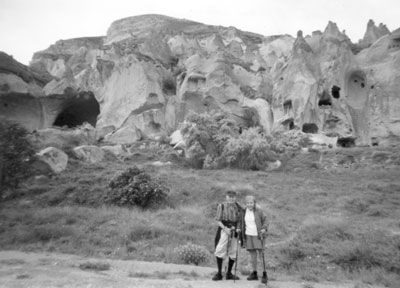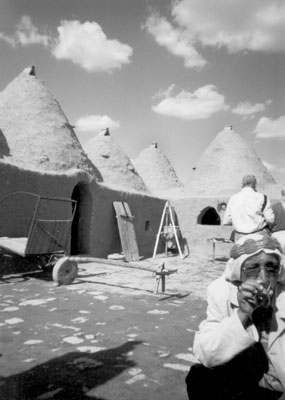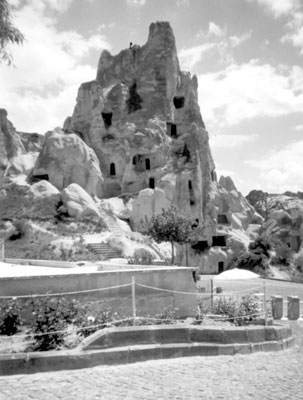Turkish delight
(First of three parts, jump to part 1, part 2, part 3)
“Çorba, çok ılık, lütfen” (“Soup, very warm, please”)*, I told the waiter when I ordered my first course.
Five minutes later, the lukewarm liquid arrived. I repeated the phrase, “Çorba, çok ılık, lütfen,” and after another three minutes the soup was put in front of me even colder than before.
I looked in my phrase book to make sure that “ılık” really meant “warm.” Satisfied, I repeated, “Ilık.”
After staring at me to make sure I was compos mentis, the server took the bowl away once more. As the minutes ticked by, I wondered how long it would take to heat up my first course. When it finally arrived, I looked for the telltale sign of steam rising from the bowl. To my dismay, I found that the soup was even colder than before.
“Ilık,” I muttered again and, as before, the nonplussed server removed the tomato concoction.
I hardly looked up the next time the waiter put the bowl in front of me. Gingerly tapping its outside in order not to get burned, my finger almost turned into an icicle. You guessed it. The soup was now ice cold!
I decided to enlist the help of one of the guests, and the next time around, miraculously, the chilled soup had been transformed into a boiling cauldron.
I found out that “ılık” means “warm” but that its connotation is “lukewarm.”
If you want a food item hot, you say “çok sicak,” which means “very hot.”
More culinary gossip
If you enjoyed the above story, read on for more culinary tidbits.
During our first day in Istanbul, my wife, Flory, and I, together with many other tourists, took the city-operated cruise on the Bosporus, the 30-kilometer-long strait separating the European part of Turkey from its Asian part and connecting the Sea of Marmara with the Black Sea.
I happened to watch a waiter hand out tall glasses of complimentary orange juice. A little later he returned to take the almost empty tumblers back to the bartender, who deftly poured the leftover liquid from several glasses together into a new glass in order to create a “fresh” full tumbler of juice, which was then served to the next unsuspecting victim.
Luckily, most passengers were too busy watching the scenery to take notice of the bartender’s machinations.
Several weeks later I noticed another hygienic masterstroke. This one relates to ekmek, the delicious Turkish bread that accompanies every meal without charge. While we were having lunch, the guests at the table in front of us departed. The waiters picked up the chewed-on bread that the customers had left on the table and added it to a basket half-full of fresh bread, making sure that the virgin slices were covering up the culprits.
In light of these experiences, it seems prudent to inspect each piece of bread served in a restaurant before putting it in your mouth. Somebody may already have been there ahead of you. As the bread episode happened at the end of our trip, we had blissfully enjoyed the ekmek all over Turkey. As far as drinks are concerned, we only used bottled ones.
Neat restaurants
Despite my comments above, Flory and I found most of the restaurants in Turkey neat and clean, with attentive service.
Before sitting down, since many establishments have no menu, we would pass by an array of delectable dishes with a cook standing behind it, ready to serve our selections. Even if there are menus, prices may not be listed. You pay when you are finished, and we always found the cost reasonable (less than $10 per person for lunch or dinner).
Once seated, I usually received a cloth napkin, which the waiter folded halfway underneath my plate while he draped the remaining part in my lap. In addition, many establishments provided numerous paper napkins for wiping the mouth. I found this much more hygienic than our custom of using the same one for both.
Frequently, as a nice touch, upon leaving a restaurant a server would spray our hands with eau de cologne — a custom especially common in eastern Anatolia.
Our guided tour
We had arranged a 21-day private tour of Cappadocia and eastern Anatolia with Argeus Tourism (Istiklal Cad. No. 7, 50400 Ürgüp, Turkey; phone 011/90 [384] 341 468 or fax 011/90 [384] 341 4888, e-mail inform@argeus.com.tr or visit www.argeus.com.tr) at a cost to us of $8,360 for two, with domestic airfare (Istanbul-Kayseri and Ankara-Istanbul), all hotels and most meals included. Our guide, Edip, and our driver, Mutlu, were waiting for us when we exited the Kayseri airport.
Rather than give you a comprehensive travelogue, I will just hit the highlights of eastern Anatolia. You can see ITN readers’ descriptions of its archaeological treasures in the July ’05 issue, pages 63-73, and in the May ’04 issue, pages 67, 69 and 73. Look for more articles by checking the ITN Reference Index in each March and September issue.
Of course, the various guidebooks (Lonely Planet and Frommer’s) and the Internet at www.tourismturkey.org, www.about-turkey.com, www.turkishembassy.org and www.kultur.gov.tr provide additional information.
Southeastern Anatolia
After a few days of sightseeing in Cappadocia, we started our tour of eastern Anatolia, a part of Turkey that is much more backward than its western portion. Absent are the tourists, the mini-malls, the built-up areas and resorts. Medieval, Middle Eastern towns dot the mountainous landscape, with summits reaching altitudes of 3,000 to 4,500 meters (10,000-15,000 feet). Immense areas of high, lava-covered plateaus are desolate and lie in contrast with the fertile valleys of the Tigris and Euphrates rivers.
We continued toward Gaziantep, a city of one million with a fascinating skyline of tall apartment buildings and even taller minarets. It is the pistachio capital of Turkey. Walking around the city, we savored the exotic fragrances in the spice market, observed the saddle makers in their narrow workshops and watched in fascination as the coppersmiths beat their sheets into brilliant bowls.
The next day, we continued to Harran, close to the Syrian border. It was hard to believe that we were in the same place where, according to the Old Testament, Abraham had resided for a while.
Harran also is renowned for its traditional “beehive” mud houses, unique in Turkey. Their layout, which ensures a comfortable temperature both in winter and summer, has been unchanged for at least 3,000 years. Can you imagine!
Most people have left the beehives for more conventional housing. You can still see a preserved model village at the Harran Kültür Evi (Harran Cultural Center).
A shortcut ferry trip across Atatürk Lake (an artificial lake made by the Atatürk dam) took us, via Diyarbakir, toward Mardin, a beautiful town whose golden stone houses blend into the rock of the hills on which the ancient city is built.
A stop in Diyarbakir was not in the cards, since the metropolis, which used to be the center of the Kurdish resistance, is now a hotbed for thieves because of its 50% unemployment.
—The Discerning Traveler is written by Philip Wagenaar.



